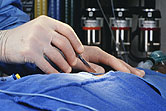
THURSDAY, June 14 (HealthDay News) — Women who have the popular plastic surgery procedure known as liposuction may be trading one form of fat for another, as a new study reveals that the sudden removal of abdominal fat seems to trigger a buildup of fat around the internal organs.
At issue, the Brazilian researchers said, is an apparent trade-off between two kinds of fat, with the removal of “subcutaneous fat” spurring the growth of “visceral fat.”
Subcutaneous fat, located directly under the skin, is the primary target of liposuction. Visceral fat wraps itself around internal organs, and its accumulation has been strongly linked to a higher risk for diabetes and heart disease.
Here’s the good news: The same research team found that liposuction patients who adopted an exercise program shortly after surgery both enjoyed the benefits of abdominal fat removal while largely preventing the post-surgical growth of visceral fat.
“Importantly, a four-month, supervised exercise program prevented this compensatory visceral fat increase, increased fat-free mass and improved physical capacity and insulin sensitivity,” the team, led by Fabiana Benatti from the University of Sao Paulo, reported.
Benatti and her colleagues detail the findings in the July issue of the Journal of Clinical Endocrinology and Metabolism.
The authors focused on the experience of 36 healthy Brazilian women between the ages of 20 and 35, all of whom underwent abdominal liposuction between 2010 and 2011 in Sao Paulo.
None of the women had a body-mass index (BMI) over 30 prior to the procedure, meaning that while they were overweight none was obese. All of the surgeries were also described as being “small-volume” in nature.
Two months post-surgery, the women were divided into two groups: the first embarked on a four-month (three times per week) exercise regimen, while the second essentially maintained a sedentary lifestyle.
Both groups were deemed to have experienced similar drops in body weight and overall fat mass as a result of their surgery, and both followed comparable diets post-procedure.
Those in the exercise group engaged in aerobic and anaerobic (weight training) training through the four-month period.
The result: Six months after their operation, neither group had regained fat in the abdominal region that was the target area of the liposuction surgery, leading the team to describe the procedure as “cosmetically efficient.”
However, patients in the sedentary group experienced a roughly 10 percent increase in visceral fat, equating to what the authors described as a “significant regain of total fat mass.” In contrast, those in the exercise group did not.
Benatti’s team said that it is not yet clear exactly how liposuction raises the risk for visceral fat growth. What is clear, however, is that exercise seems to mitigate that risk.
Lona Sandon, an assistant professor of clinical nutrition at the University of Texas Southwestern at Dallas, expressed little surprise with the findings.
“You oftentime have this snapback of the fats,” she said. “Sure, you can get rid of some of it with surgery. But if you don’t change your lifestyle, it doesn’t stay away forever. And certainly if you’ve spent all this money and incurred the risk of undergoing liposuction — and it’s not a risk-free option, by any means — why wouldn’t you want to do what you can to preserve the gain?”
“So, no, I don’t think it’s surprising that exercise helps after surgery,” Sandon added. “And in that respect, cardiovascular exercise, in particular, is one of the best ways to go. That means jogging, swimming, biking, roller blading, getting your heart rate up for an extended period of time and burning calories. Even walking helps to decrease visceral fat, even in people who have not had liposuction. And so I would expect it would work the same for people who have had liposuction.”
Connie Diekman, director of nutrition at Washington University in St. Louis, seconded the notion.
“This is a small study,” she cautioned. “And it raises the question of how this might play out among women who were significantly more overweight than those included in this study.”
“But I think there is a very important message here,” Diekman added, “in that this study is an example of how you can make a positive change with exercise. It may not ultimately prevent the return of body fat, but clearly it can change its distribution or delay its return. And that is very good news.”
More information
For more on liposuction, visit the U.S. National Library of Medicine.

